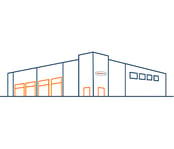This demand requires warehousing space and logistics services in strategic locations.
The Chicago area -- and particularly the Western and Southwestern suburbs -- has been dominating the country in terms of logistics and warehousing growth. Colliers International, a Canadian real estate firm, published data in early 2022, stating that Chicago's net absorption rate totaled 44.5 million square feet for 2021 -- vastly exceeding the previous record from 2016 of 26.6 million square feet. Net absorption measures the amount of occupied warehouse space minus vacated space.
ODW Logistics has operated distribution centers in the Chicago area since 2003. We've seen an increasing demand from our customers and prospects for warehouse space in the area. In 2021 we expanded our footprint by 157 percent and opened three new distribution centers in the greater Chicago area. The Chicagoland locations offer our clients excellent cost and service advantages, such as:
- Central U.S. location with access to major markets;
- Sites at or near interstate highway ramps;
- Major rail and highway logistics hub terminals;
- High-volume domestic and international airfreight services; and
- A large and productive workforce.
The Interstate-55 corridor continues to see remarkable growth for warehousing facilities. That's why two of our newest distribution centers are in Romeoville. It is a strategic location for our clients with immediate access to major interstates.
ODW Logistics opened a frozen cold-storage facility in Romeoville in December 2020 and was operating at capacity in May 2022. This spring we opened our newest distribution center -- also in Romeoville and serve multiple clients out of this 250,000-square-foot facility.
We see continued expansion opportunities in this area, especially with increased demand for frozen storage. Nowhere is the need greater than in the United States, the country with the single largest refrigerated warehouse market according to the Global Cold Chain Alliance.
Another study by VynZ Research states factors creating growth include rising e-commerce demand in the food and beverage industry, and rising consumption of fresh foods with fewer chemical preservatives. The study also notes that between storage and transport, storage is the larger segment of the cold chain market.
In addition to all this, the pandemic added a new layer of complexity and urgency to transportation in the food and beverage cold chain.
Locally, supply chain services are poised for even more growth. The Chicago Southland Economic Development Corporation says that the I-57/I-294 corridor could be home to the next mega-development multimodal site in Illinois due to its current truck and rail freight advantages and plans to construct a South suburban airport.
The local supply chain industry is so important to the Chicago Southlands that there are college-level education programs focused on this sector. For example, Moraine Valley Community College offers a full Transportation, Distribution and Logistics Program. In 2020 Governors State University received federal funding to establish its Supply Chain Innovation Center and Business Incubator.
The future looks promising for supply chain logistics in greater Chicagoland, and particularly the suburban areas along I-55 and I-294. There is available land, transportation connections to all North American markets, a skilled labor force, and experienced logistic providers already well established here.
Source: The Daily Herald










.png)

